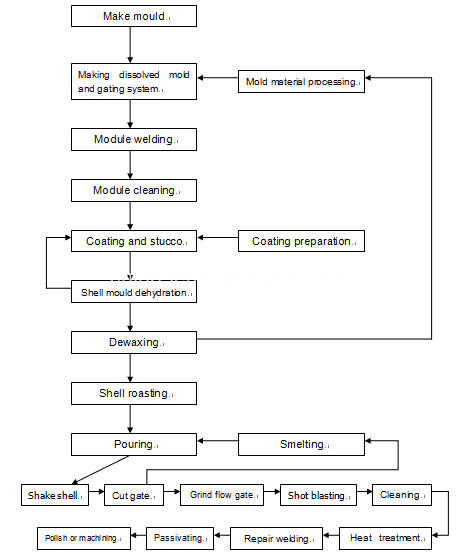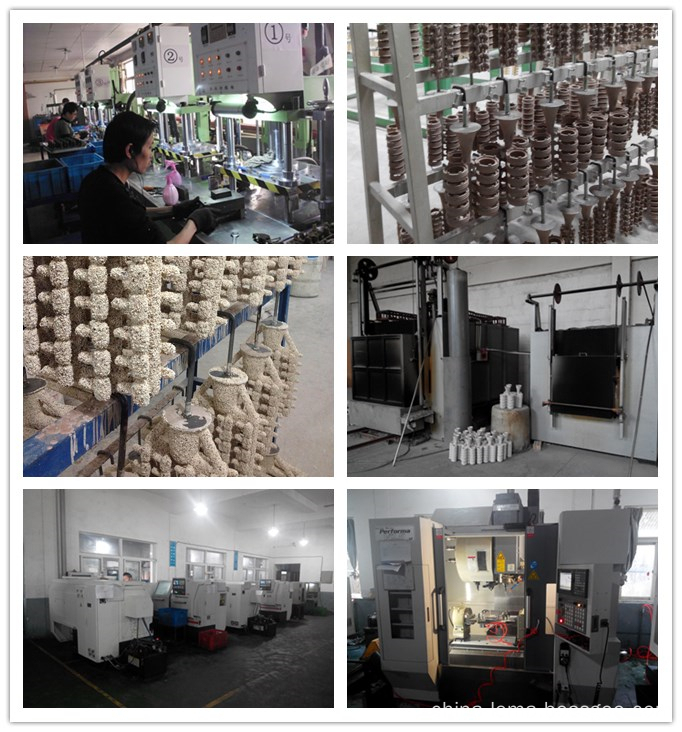Investment casting technical flow process
The silica sol casting process also called precision
investment casting process. It is a less cutting or no cutting casting
process. It is an excellent technique in foundry
industry. Its application is very extensive. It not only applicable to various
types, various kinds of alloy and casting, and produce the casting dimension
accuracy and surface quality is higher than other casting method, Even other
casting method can not do the complex, high temperature resistant, not easy
machining castings, all can be used for investment precision casting process.
The investment casting process, it is a process that use fusible
materials make soluble model, and coated with several layers of tailor-made
refractory coating on the surface, after drying and hardening become a whole
shell, melt the shell model by steam or hot water. Then put the shells in the
sand, filling dry sand in all round and modeling. Finally roasting it based on
high-temperature in the furnace, the shell after roasting, and getting the
casting part after pouring molten metal.
The investment casting process can produce High precision
dimensional parts, generally can reach to CT4-6(sand casting is CT10-13, die
casting is CT5-7). Due to the complexity of investment casting process, there
are many factors influencing the casting dimension accuracy. Such as shrinkage
of mold material, deformation of the casting, Shell heating and cooling line
quantity change in the process, alloy shrinkage and deformation of castings in
the solidification process. The surface finish of investment castings is higher
than the ordinary casting, can reach to Ra1.6~3.2.
The greatest advantages of investment casting is casting parts
have high dimensional accuracy and surface finish, so it can reduce the
mechanical processing. The another advantage of investment casting method is
that it can cast all kinds of alloy and complex casting part, special casting
high temperature alloy casting part.
The precision of the Steel Casting Part: ±0.15mm~
Smoothness of surface of rough part: Ra6.4;
Shrinkage rate of steel investment casting products: 0.6%;
Material wastage rate: 5%;
General stainless steel casting part machining allowance: 0.7mm;
Surface preparation methods: Sand blasted, Shot blasting, Powder coating,
Painting, Plating, Electrophoresis, Polishing.
Our
company's production equipment and management system
CNC machining center: 8 sets AIGEMA A-8;
CNC lathe machine: 6 Guangzhou Machines and 7 Shenyang Machines;
Work days of one week: From Monday to Saturday;
Shift work: 2 shift per day;
Working hours: From AM 8:00 to PM 5:00;
2D and 3D drawing Software: AutoCAD, UG, Pro/E, SolidWorks 2013;
QC control: New type NANO CMM, FPI M5000 desktop metal analyzer, Easson
projector, Mechanical properties tester.
The steel casting process and machining
equipment:
Steel Casting Part Stainless Steel Lost Wax Casting, Steel Casting Part, Steel Investment Casting Part, Steel Silica Sol Casting Part NINGBO BEILUN LEMA MACHINERY TECHNOLOGY CO.,LTD , http://www.china-lema.com
Since the 21st century, the global demand for carbon emissions has been increasing. The automotive industry is particularly important in this regard. On the one hand, in the field of automobile manufacturing, adopting energy-saving design can significantly reduce carbon emissions and reach production limit standards. On the other hand, for ordinary customers, energy-saving design can promote lower fuel consumption, thus truly implementing the correct concept of energy conservation and emission reduction.
The energy saving and emission reduction in the automotive industry is a system design optimization problem. As large as the engine and as small as one assembly component, Federal Mogul (Fifoment), a leading supplier of engine core components, has focused energy-saving and emission reduction on the seal-oil seal.
Founded in 1899, Federal-Mogul is headquartered in Sasfield, Michigan and is a global supplier of automotive parts and components. In recent years, Federal-Mogul has developed a new low-friction oil seal, which it calls the MicroTorq®, which offers new solutions for reducing engine power consumption and saving energy and reducing emissions. The MicroTorq® oil seal technology won the 2015 PACE Award in North America. In the North American automotive industry, the PACE award means the contribution of high-tech volume products and energy conservation and emission reduction. How can a small oil seal play a role? What? According to Federal-Mogul data, the oil seal can reduce friction losses by up to 80%, and the CO2 emission reduction per engine can reach 1.5g/km.
Can you really achieve such impressive results? It should be noted that when the internal combustion engine is operating, more than 70% of the fuel energy will be lost due to associated effects. The oil seal acts as a dynamic seal. Its function is to seal the oil of the engine from leaking on the one hand, and to prevent the foreign material from entering the engine on the other hand. Due to the continuous contact with the running shaft, the oil seal will continue to generate friction torque during operation, and the power loss will always exist. In this respect, Micron's MicroTorq® oil seal technology developed by FM&Mohs is providing customers with a low-friction solution. The goal is to reduce the friction torque of the oil seal itself and reduce the contact friction between the small oil seal and the rotating part, thereby reducing fuel consumption. The purpose of reducing emissions.
To further understand the details of the Molex MicroTorq® oil seal technology, the reporter interviewed Steve Davis, global engineering director of the Federal-Mogul Powertrain seal business. He introduced MicroTorq® oil seal technology with five product features. The first is the ease of installation. The final cause of functional problems in most oil seal products is the installation error. The MicroTorq® has been designed with the structural features of the auxiliary mounting to improve the part's installability. The second is a static seal ring. The main engine plant will perform on-line air tightness inspection after the oil is packaged into the machine to check the sealing performance of the engine oil seal. The MicroTorq® oil seal is provided with a continuous concentric sealing ring closest to the inside of the engine (oil side) to ensure effective operation. Hermeticity. The third is the spiral auxiliary seal, which is located on the main lip and is a continuous spiral structure. Through the pumping effect, the oil pump in the engine is sent back, the same principle as the PTFE oil seal on the market. Fourthly, the MicroTorq® oil seal has a dust-proof lip integrally designed at the end of the main lip. The continuous concentric sealing ring effectively blocks the outside dust, garbage and even sewage from the engine crankcase. The fifth is the most important innovative design of a double-flexible flexible section of the MicroTorq® seal. The crankshaft is not very stable around a concentric circle during operation, but there is a pendulum jump. MicroTorq® oil seals can change two fulcrums, which can effectively reduce the swing of the rotary shaft during the operation of the sealing performance of the seal. The effect is that within the operating range of the engine, the contact sealing force of the part of the main lip can be maintained to be consistent, thereby allowing the contact force to be appropriately reduced in the original design, the contact force being reduced, and the frictional loss naturally reduced. Other low-friction oil seals on the market do not have this feature, Steve Davis said.
Obviously, with some details, the reporter still has doubts: In the field of passenger cars and commercial vehicles, in the field of miniaturized engines and heavy-duty engines, the applicability and advantages of MicroTorq® oil seals are comparable to those on the market. Is a low-friction oil seal competitive? In addition, MicroTorq® has another special point, Steve Davis said. Its radial thickness and axial width can be made smaller than traditional oil seal sizes. One of the benefits that brings customers directly is the flexibility of engine design. MicroTorq® oil seals can cater to the design of the customer's engine and provide more favorable conditions for miniaturization. When Steve Davis talks about heavy-duty engines, the large engine crankshaft has a large size, including the surface quality of parts and the value of the crankshaft pendulum jump will be more complicated than the case of small gasoline engine, the oil seal can be adjusted by the corresponding design and integrate a set of auxiliary defense. Dust lip to meet the harsh environment of heavy-duty engines. According to Steve Davis, Federal-Mogul is currently working with a global heavy-duty engine manufacturer and the test results are optimistic. In terms of price competitiveness, Steve Davis said that not only in China, MicroTorq® has always been very competitive in the past year when we quoted in various regions.
According to report, the layout of MicroTorq® oil seal business in China is also accelerating, and Federal-Mogul will bring its first MicroTorq® oil seal production line in Nanchang factory in December of this year, and OTS will be submitted for customer assessment in early 2017. By 2021, global production will reach more than 10 million, of which nearly one-third will be produced in Nanchang, China, and supply the local market.
In today's automotive industry, engine manufacturers continue to face the challenges of stringent fuel economy and carbon emission standards. They need to constantly adjust engine designs to meet emission reduction requirements. The industry needs to make innovative contributions in this regard. 
